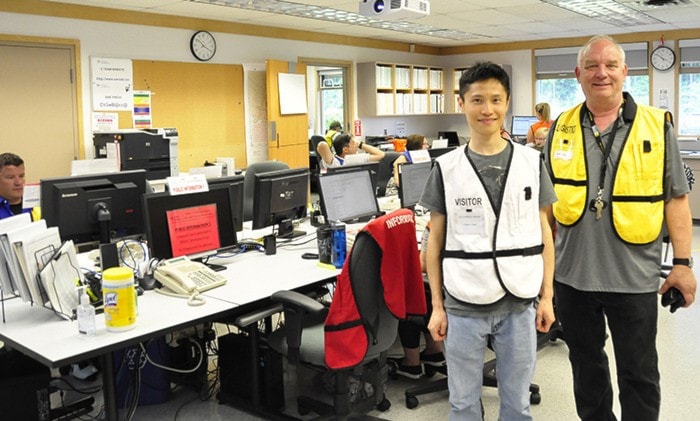A natural disaster along B.C.’s West Coast could put Simon Fraser University’s Surrey campus into the thick of the region’s emergency communications response.
A high-speed, wireless link that connects the campus to the nearby Surrey-based Provincial Regional Emergency Operations Centre (PREOC) supports ongoing SFU research at the centre– and would also serve as a vital backup communications lifeline for the region.
“Beyond facilitating our research, this link serves as a critical backup communications link for Emergency BC (EMBC), and all of the supporting emergency agencies and utilities that may be called upon to assist at the PREOC in support of a large scale emergency in Southwestern B.C.,” said Peter Anderson, director of SFU’s Telematics Research Lab (TRL) in the School of Communication.
Anderson and colleague Stephen Braham played a backup role in the recent Cascadia Rising emergency exercise, which simulated the consequences of and responses to a 9.0 magnitude earthquake on the West Coast. In the event of a real emergency the Surrey PREOC would be the region’s hub, coordinating communications and emergency response and recovery operations with communities from Vancouver to Pemberton and Boston Bar.
The SFU Surrey link was originally established by the TRL, in conjunction with SFU Network Services, to support the University’s participation in emergency arrangements for the 2010 Olympics.
Since then Anderson and Braham have continued to refine SFU’s backup capabilities, including systems embedded in the University’s Advanced Mobile Emergency Communications (AMECom) vehicle. The unit was conceived and outfitted by Anderson and Braham at SFU’s Burnaby campus and is now housed permanently at the PREOC.
The vehicle also provides a test-bed to develop new generations of mobile communication support systems, and currently serves as an active emergency response capability for B.C. and local authorities.
Since initially created more than a decade ago, the vehicle has been dispatched to myriad provincial emergencies, including floods and wildfires, and was on standby during the recent Fort McMurray and northern B.C. fires.
A mobile satellite trailer is also stationed at the PREOC.
“There are wide-ranging challenges to emergency communications and disaster planning throughout the province,” says Anderson. “A 900 km flight up B.C.’s coast translates into over 26,000 km of intricately winding coastline. Given its remote channels and physical ruggedness this is one of the toughest places in the world in which to communicate.” Anderson’s ongoing work is also helping to inform plans to refine B.C.’s tsunami warning system.
“Through our work at SFU, the University has become a national leader in emergency communications,” says Anderson. “After years of research and remote testing we can now deploy our systems virtually anywhere.
“Our latest system connects to networks through a variety of different means including satellite systems, as well as existing Internet services,” he says.
“We’ve been testing the technology in Metro Vancouver, the Central Interior and in the Yukon, and have become the national lead for developing a rapid, deployable public safety broadband LTE cellular system.”
Anderson, who continues to fine-tune and test systems, also draws from the experiences responses to international disasters and has visited the sites of many of the world's most devastating events.
Fast Facts:
• Anderson has played key roles in areas of emergency preparedness and disaster mitigation throughout the province and far beyond.
• A pioneer in using the internet for disaster reduction, Anderson developed and supported the first email gateway for distributing the United Nation’s disaster situation reports and appeals for assistance, along with the first websites for provincial, federal and UN disaster programs.
• Anderson was instrumental in assisting with emergency response communication during the 2003 Okanagan/Central Interior forest fires, a role he took on after heading to Kamloops to volunteer his services.
• In 2004, he visited Sri Lanka just days after the tsunami and spent the next three years working with government and community stakeholders to devise a community-based warning system that would aid coastal communities, collaborating further on a new Indian Ocean tsunami-warning system project centered in Thailand. His early-warning systems approaches have since been applied to rural coastal stretches of B.C.
• Anderson began his emergency communication research outreach in war-torn Sudan in the late 1970s, where he worked to develop a communication system with SFU colleagues and researchers at Juba University.
• He has provided expertise to the United Nations, creating high-tech systems for its disaster relief program, and continues a long-standing relationship with Emergency Management B.C., creating and testing new systems for emergency preparedness, as well as local search and rescue.
